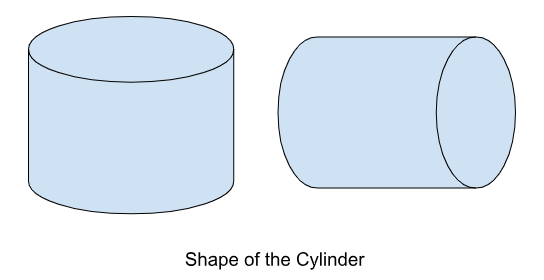Table of Contents
The volume of the Cylinder measures the amount of space occupied by a cylinder. Think of it as the amount of water a container can hold. In the case of a cylinder, the Volume of the Cylinder tells us how much it can store. The formula for the volume of a cylinder is:
Cylinder Volume = πr2h
The radius (r) and height (h) of the cylinder are essential in determining its volume. By multiplying the area of the circular base (πr2) by the height (h), we can find the volume of the cylinder.
Why understand the Volume of the Cylinder?
Calculating the Volume of Cylinders is essential in engineering, architecture, fluid mechanics, and everyday life applications. Engineers use the Volume of Cylinders to design pipes, cylinders, and storage tanks, while architects consider it when designing cylindrical structures. Moreover, in fields like fluid mechanics, understanding the volume of a cylinder is vital for fluid flow analysis. The practical implications of this knowledge make it a valuable skill for professionals and students alike.
This article discusses the Volume of the Cylinder briefly.
A cylinder is a three-dimensional geometric shape characterised by two parallel circular bases lying on the same plane. The lateral surface of the cylinder is formed by connecting the edges of the circular bases with a curved surface. This results in a hollow, tube-like structure with a constant cross-sectional shape throughout its height.
In the context of geometry, a cylinder is often considered a right circular cylinder, meaning that the axis, which passes through the centres of the circular bases, is perpendicular to the bases. As a result, the shape exhibits rotational symmetry around its central axis.
Volume of a Cylinder: Formula
The formula used to calculate the volume of a cylinder is a fundamental mathematical expression that provides a direct and efficient means to determine the space occupied by this three-dimensional shape. The formula of the volume of a cylinder is given by:
The Volume of a Cylinder, V = πr2h
Where:
V represents the volume of the cylinder,
π (pi) is a mathematical constant approximately equal to 3.14159,
r denotes the radius of the circular base of the cylinder, and
h represents the height or the distance between the two bases.
This simple yet versatile formula is the cornerstone for solving various cylinder problems, from academic exercises to real-world engineering applications.
Volume of the Cylinder: Units of Measurement
In scientific and engineering contexts, the volume of a cylinder is typically expressed in cubic units. Commonly used cubic units include cubic centimetres (cm³), cubic meters (m³), cubic inches (in³), and litres (L). The unit’s choice depends on the cylinder’s scale and the application.
Volume of the Cylinder: Volume Formulas of Different Shapes
The volume formulas for the three 3D shapes are as follows:
Volume of the Cylinder: Vcylinder = πr2h
Volume of the Sphere: Vsphere = (4/3)πr3
Volume of the Cuboid: Vcuboid = lwh
Where
Vcylinder denotes the volume of the cylinder.
Vsphere represents the volume of the sphere.
Vcuboid signifies the volume of the cuboid.
π is the mathematical constant approximately equal to 3.14159.
r denotes the radius of the cylinder or sphere, respectively.
h signifies the height of the cylinder.
l, w, and h denote the cuboid’s length, width, and height, respectively.
Volume of the Cylinder: Examples
Question: Calculate the volume of a given cylinder having a height of 10 cm and a base radius of 21 cm. (Take pi = 22/7)
Solution:
Given: Height = 10 cm
Radius = 21 cm
We know that;
Volume, V = πr2h cubic units
Therefore, V = (22/7) × 21 × 21 × 10
V= 13,860 cm3
Therefore, the volume of a cylinder = 13,860 cm3
Question: Calculate the radius of the base of a cylindrical container of volume 440 cm3. The height of the cylindrical container is 35 cm. (Take pi = 22/7)
Solution:
Given: Volume = 440 cm3
Height = 35 cm
We know that,
Volume, V = πr2h cubic units
So, 440 = (22/7) × r2 × 35
r2 = (440 × 7)/(22 × 35)
r2 = 3080/770 = 4
Therefore, r = 2 cm
Therefore, the radius of a cylinder = 2 cm.
FAQs on Volume of the Cylinder
What is meant by the volume of a cylinder?
In geometry, the volume of a cylinder refers to the capacity or amount of space that a cylinder can hold. It represents the three-dimensional measure of the interior region within the cylinder's curved surface and between its two circular bases.
What is the formula for the volume of a cylinder?
The formula to calculate the volume of a cylinder involves multiplying the area of its circular base by its height. Since the base of a cylinder is circular, the formula can be stated as follows:
The volume of a cylinder = π * r^2 * h cubic units. where r represents the radius of the circular base, and h denotes the height of the cylinder.
What is the volume of a hollow cylinder?
A hollow cylinder is a type of cylinder that is empty from the inside and has a difference between its internal and external radii. The volume of a hollow cylinder refers to the amount of space occupied by this space in three-dimensional terms.
How to calculate the volume of a hollow cylinder?
To calculate the volume of a hollow cylinder, you need to know the external radius (R), the internal radius (r), and the height (h). The formula for calculating the volume of a hollow cylinder is given by: V = π(R2 - r2)h cubic units.
What is the unit for the volume of a cylinder?
The volume of a cylinder is generally measured in cubic units. Commonly used cubic units for volume measurement include cubic centimetres (cm³), cubic meters (m³), cubic feet (ft³), and others, depending on the scale of the cylinder.










